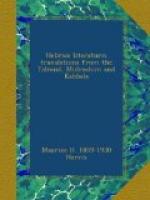“Ye shall take for yourselves the fruit of the tree hadar” (the citron). Its color is high yellow and resembles fire. The second species is the palm branch (Heb. Lulab). The palm is a high tree, growing up straight in the air, and its fruit is sweet and delicious to the taste; this then represents the second element, air. The third is the bough of the myrtle, one of the lowliest of trees, growing close to the ground; its nature, cold and dry as earth, fits it to represent that element. The fourth is “the willow of the brook,” which grows in perfection close beside the water, dropping its branches into the stream, and symbolizing thus the last element, water.
The Bible teaches us that for each of these four elements we owe special thanks to God.
The citron we hold in the left hand, and the other three we grasp together in the right. This we do because the citron contains in itself all that the others represent. The outside skin is yellow, fire; the inside skin is white and damp, air; the pulp is watery, water; and the seeds are dry, earth. It is taken into the left hand, because the right hand is strongest, and the citron is but one, while the other emblems are three.
These four emblems represent likewise the four principal members of the human body. The citron is shaped somewhat like a heart, without which we could not live, and with which man should serve his fellows; the palm branch represents the spine, which is the foundation of the human frame, in front of which the heart lies; this signifies that we should serve God with our entire body. The branches of the myrtle resemble a human eye, with which man recognizes the deeds of his fellows, and with which he may obtain a knowledge of the law. The leaves of the willow represent the lips, with which man may serve the Eternal and thank Him. The myrtle is mentioned in the Bible before the willow, because we are able to see and know a thing before we can call its name with our lips; man is able to look into the Bible before he can study the same. Therefore, with these four principal parts of the human frame should we praise the Creator, as David said, “All my bones shall say, O Lord, who is like unto Thee?”
Maimonides, in his work called Moreh Nebuchim ("The Guide of the Perplexed"), explains that God commanded the Israelites to take these four emblems during this festival to remind them that they were brought out from the wilderness, where no fruit grew, and no people lived, into a land of brooklets, waters, a land flowing with milk and honey. For this reason did God command us to hold in our hands the precious fruit of this land while singing praises to Him, the One who wrought miracles in our behalf, who feeds and supports us from the productiveness of the earth.
The four emblems are different in taste, appearance, and odor, even as the sons of men are different in conduct and habits.
The citron is a valuable fruit; it is good for food and has a most pleasant odor. It is compared to the intelligent man, who is righteous in his conduct toward God and his fellow-man. The odor of the fruit is his good deeds; its substance is his learning, on which others may feed. This is perfect among the emblems, and is, therefore, always mentioned first, and taken by itself in one hand.




